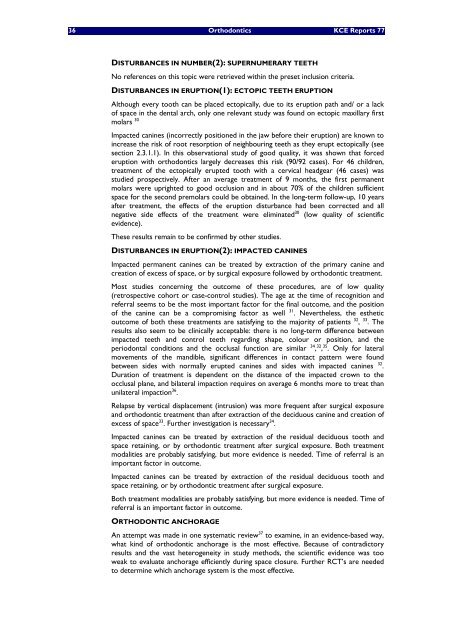The report is available in English with a Dutch summary - KCE
The report is available in English with a Dutch summary - KCE
The report is available in English with a Dutch summary - KCE
Create successful ePaper yourself
Turn your PDF publications into a flip-book with our unique Google optimized e-Paper software.
36 Orthodontics <strong>KCE</strong> Reports 77<br />
DISTURBANCES IN NUMBER(2): SUPERNUMERARY TEETH<br />
No references on th<strong>is</strong> topic were retrieved <strong>with</strong><strong>in</strong> the preset <strong>in</strong>clusion criteria.<br />
DISTURBANCES IN ERUPTION(1): ECTOPIC TEETH ERUPTION<br />
Although every tooth can be placed ectopically, due to its eruption path and/ or a lack<br />
of space <strong>in</strong> the dental arch, only one relevant study was found on ectopic maxillary first<br />
molars 30<br />
Impacted can<strong>in</strong>es (<strong>in</strong>correctly positioned <strong>in</strong> the jaw before their eruption) are known to<br />
<strong>in</strong>crease the r<strong>is</strong>k of root resorption of neighbour<strong>in</strong>g teeth as they erupt ectopically (see<br />
section 2.3.1.1). In th<strong>is</strong> observational study of good quality, it was shown that forced<br />
eruption <strong>with</strong> orthodontics largely decreases th<strong>is</strong> r<strong>is</strong>k (90/92 cases). For 46 children,<br />
treatment of the ectopically erupted tooth <strong>with</strong> a cervical headgear (46 cases) was<br />
studied prospectively. After an average treatment of 9 months, the first permanent<br />
molars were uprighted to good occlusion and <strong>in</strong> about 70% of the children sufficient<br />
space for the second premolars could be obta<strong>in</strong>ed. In the long-term follow-up, 10 years<br />
after treatment, the effects of the eruption d<strong>is</strong>turbance had been corrected and all<br />
negative side effects of the treatment were elim<strong>in</strong>ated 30 (low quality of scientific<br />
evidence).<br />
<strong>The</strong>se results rema<strong>in</strong> to be confirmed by other studies.<br />
DISTURBANCES IN ERUPTION(2): IMPACTED CANINES<br />
Impacted permanent can<strong>in</strong>es can be treated by extraction of the primary can<strong>in</strong>e and<br />
creation of excess of space, or by surgical exposure followed by orthodontic treatment.<br />
Most studies concern<strong>in</strong>g the outcome of these procedures, are of low quality<br />
(retrospective cohort or case-control studies). <strong>The</strong> age at the time of recognition and<br />
referral seems to be the most important factor for the f<strong>in</strong>al outcome, and the position<br />
of the can<strong>in</strong>e can be a comprom<strong>is</strong><strong>in</strong>g factor as well 31 . Nevertheless, the esthetic<br />
outcome of both these treatments are sat<strong>is</strong>fy<strong>in</strong>g to the majority of patients 32 , 33 . <strong>The</strong><br />
results also seem to be cl<strong>in</strong>ically acceptable: there <strong>is</strong> no long-term difference between<br />
impacted teeth and control teeth regard<strong>in</strong>g shape, colour or position, and the<br />
periodontal conditions and the occlusal function are similar 34 , 32 , 35 . Only for lateral<br />
movements of the mandible, significant differences <strong>in</strong> contact pattern were found<br />
between sides <strong>with</strong> normally erupted can<strong>in</strong>es and sides <strong>with</strong> impacted can<strong>in</strong>es 32 .<br />
Duration of treatment <strong>is</strong> dependent on the d<strong>is</strong>tance of the impacted crown to the<br />
occlusal plane, and bilateral impaction requires on average 6 months more to treat than<br />
unilateral impaction 36 .<br />
Relapse by vertical d<strong>is</strong>placement (<strong>in</strong>trusion) was more frequent after surgical exposure<br />
and orthodontic treatment than after extraction of the deciduous can<strong>in</strong>e and creation of<br />
excess of space 33 . Further <strong>in</strong>vestigation <strong>is</strong> necessary 34 .<br />
Impacted can<strong>in</strong>es can be treated by extraction of the residual deciduous tooth and<br />
space reta<strong>in</strong><strong>in</strong>g, or by orthodontic treatment after surgical exposure. Both treatment<br />
modalities are probably sat<strong>is</strong>fy<strong>in</strong>g, but more evidence <strong>is</strong> needed. Time of referral <strong>is</strong> an<br />
important factor <strong>in</strong> outcome.<br />
Impacted can<strong>in</strong>es can be treated by extraction of the residual deciduous tooth and<br />
space reta<strong>in</strong><strong>in</strong>g, or by orthodontic treatment after surgical exposure.<br />
Both treatment modalities are probably sat<strong>is</strong>fy<strong>in</strong>g, but more evidence <strong>is</strong> needed. Time of<br />
referral <strong>is</strong> an important factor <strong>in</strong> outcome.<br />
ORTHODONTIC ANCHORAGE<br />
An attempt was made <strong>in</strong> one systematic review 37 to exam<strong>in</strong>e, <strong>in</strong> an evidence-based way,<br />
what k<strong>in</strong>d of orthodontic anchorage <strong>is</strong> the most effective. Because of contradictory<br />
results and the vast heterogeneity <strong>in</strong> study methods, the scientific evidence was too<br />
weak to evaluate anchorage efficiently dur<strong>in</strong>g space closure. Further RCT’s are needed<br />
to determ<strong>in</strong>e which anchorage system <strong>is</strong> the most effective.
















